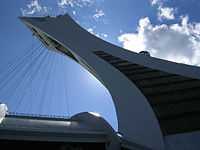Inclined tower

An inclined tower is a tower that was intentionally built at an incline. The world's most popular inclined tower, despite the fact that it was not originally projected, designed, nor was it supposed to be inclined, is the Torre di Pisa, in Pisa, Italy. The world's tallest inclined tower is the tower of Olympic Stadium in Montreal, Quebec, which stands at 574 ft (approx. 175 metres). The Puerta de Europa in Madrid is a matching pair of inclined towers. An inclined tower is used to hold the roof of Schwarzwald-Baar-Center, a mall in Villingen-Schwenningen, Germany.
Other examples
Sometimes transmission towers of powerlines running over steep mountains are built as inclined towers. Many of such electricity pylons can be found at Hoover Dam and in Switzerland.
Inclined towers are also used at some aerial tramways as support pillars, and at bridge towers as in the case of Hong Kong–Shenzhen Western Corridor.

See also
- Leaning tower
- Round tower
External links
- Inclined towers as electricity pylons at Hoover Dam
- Inclined Pylon of the Rhine Valley Line at Sargans at Structurae